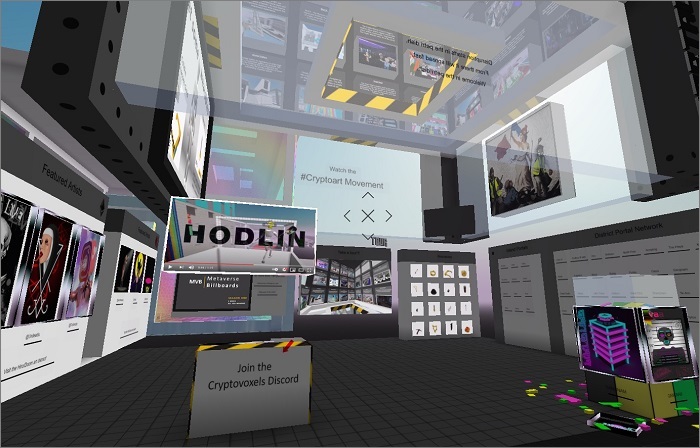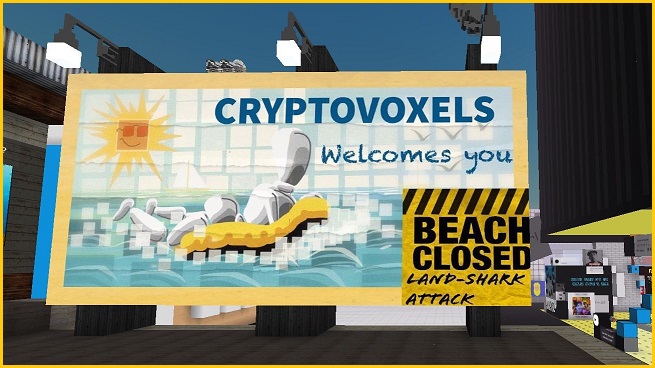The first time we are introduced to the Metaverse – a virtual reality world – in Neal Stephenson’s 1992 cyberpunk novel Snow Crash, samurai/hacker/pizza delivery driver Hiro Protagonist hooks into his computer and sees “a boulevard that stretches off into an infinite blackness”.
“The boulevard does not really exist,” the narrator explains. “It is a computer-rendered view of an imaginary place.”
Stephenson’s pre-Matrix vision of a fully-fledged digital world where hackers and wealthy elites gather to share secrets and catch a glimpse of online celebrities inspired a generation of coders, artists, and thinkers to imagine a version of the Metaverse during the dawn of the internet age.
Among the inspired was Ben Nolan, founder of Cryptovoxels – a virtual world built on the Ethereum blockchain.
When you open Cryptovoxels in your browser, you are greeted with a boulevard stretching off into an infinite purple haze.
Once the assets load, you find yourself standing in an art gallery filled with image and sound from the latest cryptocurrency gold rush: non-fungible tokens (NFTs), a cryptographically-signed asset taking the art world by storm.
Inside Cryptovoxels, artists clamber for your attention, inviting you inside their personal galleries lined with limited edition artworks all minted and traded on the blockchain.

Collectors of NFT art can show off their collections in virtual galleries. Image: supplied.
Even the virtual space inside Cryptovoxel is an NFT, with parcels of digital real estate being be traded on secondary markets like OpenSea.
A new gold rush
Recent interest in NFTs and cryptocurrencies has seen a surge in traffic through Cryptovoxels which is helping push the price of its NFT land into the tens of thousands of dollars in some cases.
When Information Age spoke with Nolan in March he had just come off fixing a minor enviable crisis caused by Cryptovoxels’ sudden popularity.
“We just had too much load,” he said. “It was growing too fast.”
From his home office in New Zealand’s capital city Wellington, Nolan apologised to his wife, brewed some coffee, and got to scaling up his vision to meet the excess demand.
“It took 15 pots of coffee and really loud music all day, but we got everything migrated and now it's all running well – touch wood.”
Cryptovoxels has a small team – five in total with only three working full-time – meaning Nolan is often left with much of the technical work in keeping the virtual world alive and helping implement new features.
As much as he enjoys the hands-on approach, the young entrepreneur is also aware of concerns among his community of users – many of whom have staked actual money on buying parcels of land and artworks to furnish it – about what happens if Nolan is no longer around to keep the digital lights on.
He said the hurdles for his blockchain business aren’t technical, even though Nolan is still iterating new features.
“It's just about building the team now and making the team able to run by itself without me,” Nolan said.
“For a long time I had my hands on everything and now the team is getting a lot more independent which means I can concentrate on the new stuff.”

Cryptovoxels founder Ben Nolan was inspired by the cyperpunk fiction of Neal Stephenson. Image: supplied.
The ‘new stuff’ are Cryptovoxels’ next steps away from being just a browser experience into mobile and, crucially, virtual reality.
Within minutes of walking around Cryptovoxels, you can see how well-suited it would be for virtual reality; a strange new world of memes, bright colours, and bizarre architecture designed and created by artists still waiting to find mainstream attention.
Built to last
Despite being at the foundation of a new digital art movement, though one not without its critics, Nolan holds onto his modest antipodean attitude when it comes to Cryptovoxels.
He’s not running the virtual world like a Silicon Valley startup that burns through cash to reach maximum exposure while endlessly chasing venture capital funds.
Nolan’s financial conservatism mitigates some of the valid concerns critics of the current NFT gold rush have pointed out – namely that many of these valuable crypto tokens could disappear once the startups serving them fall apart.
Short version:
— Jonty Wareing (@jonty) March 17, 2021
The NFT token you bought either points to a URL on the internet, or an IPFS hash. In most circumstances it references an IPFS gateway on the internet run by the startup you bought the NFT from.
Oh, and that URL is not the media. That URL is a JSON metadata file
“My default position was this is all going to blow over and I'll need to find a job and pay hosting fees for the next 20 years,” Nolan told Information Age.
“We've always kept a really big buffer to do that and I think we could pay for a lot longer than 20 years now.
“It's always been about keeping the costs low and just being really conservative with what we do with our sales and use that to basically pay for hosting forever.
“So if everyone left and there was no one interested in cryptovoxels anymore, I expect the city to be still viewable fast loading.”
The company primarily makes money through the sale of new parcels of land but it also gets royalties when land is re-sold by users on the secondhand market.
For Nolan, blockchain has never been a get-rich-quick scheme. He wants to build something that lasts while also helping usher in the next era of online communications and communities.
“I really like old websites that are still up from, you know, 2002,” he said.
“It's really important to me that Cryptovoxels continues to exist as well.”
But first he’s got to keep the world running as the flood of new users arrive.










